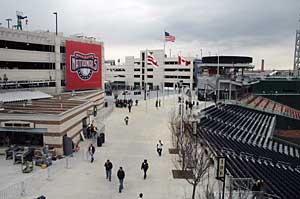Baseball players are hardly alone in experiencing opening-day jitters. Less than a week before the March 30th opening of the Washington Nationals’ new home, the first LEED-certified Major League Baseball stadium, scores of bricklayers, painters, electricians, and other contractors were still hard at work. Designed by a joint venture between the international firm HOK Sport, and D.C.-based Devrouax + Purnell Architects, the $611 million ballpark was erected in just under two years.



Nationals Park sits on South Capitol Street, a formal axis in Pierre Charles L’Enfant’s 1791 city plan, a dozen blocks south of the Capitol’s iconic white dome. HOK Sport senior project designer Jim Chibnall says that the cityscape inspired his design and materials palette. Cladding the steel-framed structure are roughly 58,000 cubic yards of the beige precast concrete, which resembles the limestone common in D.C.’s landmarks, as well as glass and metal panels.
While locals have largely refrained from criticizing the subdued architecture, failure to include adequate parking at the 41,888-seat stadium has ignited outrage. The team only promised spaces to season ticket holders, who number roughly 18,000. Most fans will need to take the subway, taxi, walk, or bicycle. They can also park three miles away at the Nationals’ former home, the 46-year-old Robert F. Kennedy Memorial Stadium, and take a free shuttle bus.
This unplanned, heavy reliance on public transportation is now being touted as one of the stadium’s green assets, but other sustainable features were always intended as such. Susan M. Klumpp, an HOK principal and LEED program manager, says that the elements which earned the stadium its LEED Silver certification include: construction materials made of up to 20 percent recycled content; energy-efficient lighting; a 6,300 square-foot green roof; and adjustable, low-flow plumbing that is expected to save 3.6 million gallons of water annually. The project also features storm-water management designed to prevent debris from further fouling the nearby Anacostia River.
Like many urban waterways, the Anacostia was once lined with industrial operations. Nationals Park occupies a brownfield site formerly home to an asphalt plant. Now the neighborhood’s sewage pumping station and other industrial structures share turf with gleaming new office buildings. Condominiums are also in the works. “It’s a gateway into the city,” says Devrouax + Purnell founding principal Paul S. Devrouax, Jr., FAIA. “It’s a quite vibrant area. The stadium is really going to enhance the surrounding community. It can only spark economic development.”


Post a comment to this article
Report Abusive Comment